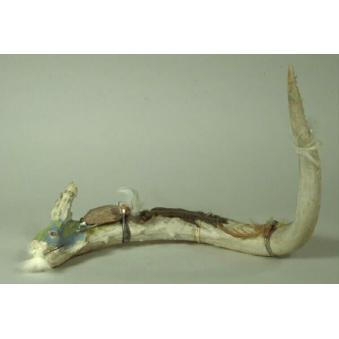
Photograph by IARC staff. Copyright 1994 School for Advanced Research.
Carving, kolowisi
Date: 1970s
Artist or Maker: Unknown
Dimensions:
25.4 cm (10 in.)
Medium: antler | paint | turquoise | beads | feathers | stone
Credit Line: Bequest of Rick Dillingham, II; recieved at the Indian Arts Research Center in 1994.
Place Made:
Zuni Pueblo, McKinley County, New Mexico, Southwest, United States, North America
Object Number: SAR.1994-4-604
Not on view
Tribal Collection Review RemarksJim Enote and Octavius Seowtewa during collection review visit April 6 and 7, 2009 (Events Record “Collection Review: Zuni Tribe, Review 1”): This is a carving made from a deer antler, wrapped with deer sinew. It is not ceremonial. It is carved to represents a snake, which is kolowisi in the Zuni language. It was painted with commercial paint. It was made for sale (not for personal, household, or ceremonial use in the community). It should not be referred to as a fetish because it is not made correctly to be one and therefore could not be used for the purposes for which a fetish would be used. It may be made available to anyone for research, photography, and publication. It has no special handling or storage requirements.
Though carvings such as this, usually depicting an animal, are frequently referred to as “fetishes,” it is important to note that they are not true fetishes. True fetishes are made and used specifically for spiritual or ceremonial purposes and uses. This type of item, however, is made specifically for sale. It is more appropriate to refer to commercially-made figures of this type as “carvings.”
Carvings produced for commercial purposes depict a wide variety of animals, but there are only six animal depictions that can become true fetishes. They are animals that are associated with the six directions, which are each associated with a particular color. The six animals should be carved from a stone that is the color of the associated direction. The six animals and their corresponding directions/colors are: Mountain Lion-North-Yellow; Bear-West-Blue; Badger-South-Red; Wolf-East-White; Eagle-Sky (Up)-Multi-color; Mole or Shrew-Underworld (Below)-Black. Any of these six animal carvings can become a true fetish, IF it is given a spiritual life by certain Zuni religious leaders. These fetishes would be used by Zuni people for protection, and by Zuni hunters, depending on which animal is chosen for the fetish, for assistance in the hunt.
In Collection(s)
The Indian Arts Research Center, in collaboration with Native American community scholars, strives to present accurate collections records. Records may be updated as new information becomes available and is reviewed with the Native American community having cultural affinity to particular items. Please write to iarc@sarsf.org if you have questions or concerns related to the documentation.
